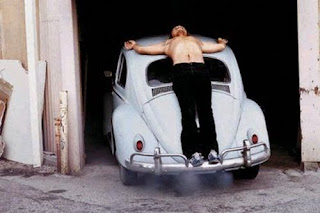 |
| Urban Lights Chris Burden, 2008 collections.lacma.org |
On May 10, 2015, the art world grew a little dimmer with the death of Chris Burden. Chris Burden was best known for his installation Urban Lights (2008), located in the Renzo Piano-designed piazza between the Ahmanson Gallery and the Resnick Pavilion. The late Mr. Burden first made his name as a performance artist, in the early seventies, with the piece Five Day Locker Piece (1971). His most famous piece was Shoot (1971), where he was shot in the arm by an assistant. Trans-Fixed (1974) was his most reproduced performance piece, making its way into eighties popular culture via the lavishly produced "Wild Boys" video, by the English quintet, Duran Duran. Rather than use this space to write an obituary to Chris Burden, Blogger would like to focus on Chris Burden's architectural sensibility. Our guide for today is our favorite critic Christopher Hawthorne and his recent article "Chris Burden's architectural intelligence." It is an timely ode to Urban Lights and its function within the Los Angeles County Museum of Art.
 |
| Chris Burden among the lamp posts latimes.com |
 |
| Watts Towers and Urban Lights lacma.org |
Urban Light has become one of the most photogenic places on the museum campus but more than that, it "...has given a significant boost to LACMA's goal of activating the long-dormant seam between the museum and the boulevard." In other words, Urban Light has become a selfie magnet, which in this day and age of instantaneous fame, seems only natural.
 |
| Posing at Urban Lights en.wikipedia.org |
The basic architectural nature of Urban Light is found in Chris Burden's description, a building with a with roof of light. Investing his work with an architectural character was not an out-of-place thing for the late artist. In 2003, he told an audience at the Southern California Institute of architecture,
Originally I was going to study architecture...Pomona College didn't have a specific architectural program, so you took physics classes and art classes, and that was considered how you got your BFA in architecture. As time went on, I realized that I wanted to be an artist, mostly because I had worked a couple of summers in an architectural office and seemed then to me that you had to be my age--that I am now--before you got to make any decisions. Whereas in sculpture I could get something done right away. So that's the path I chose.
If you examine the oeuvre of Mr. Burden's work, you can find a running theme of architecture and urbanism, with the wink/nod approach to the relationship between the structure and art-making suggested by the installation.
Chris Burden added, Also, the physics at Pomona got harder and harder and I was competing with sort the whiz kids of the physics world. They were content to spend 30 to 40 hours on a calculus equation. That wasn't interesting to me."
 |
| Wexner Castle Chris Burden (1990) Columbus, Ohio flawedart.net |
 |
| An exhibit from "Extreme Measures" October 2, 2013-January 12, 2014 New Museum newmuseum.org |
Ghost Ship (2005) was an boat that was sent on an unmanned voyage, controlled from the off the coast of Scotland. This boat was attached to the façade of the New Museum. On the museum's roof was a tribute to the destroyed World Trade Center Towers titled, Quasi-Legal Skyscrapers, work with deep roots in the Topanga Canyon experimentations of Mr. Burden.
 |
| Close up of Ghost Ship (2005) Benoit Pailley/New Museum observer.com |
"Burden carried out" a kind of outsider architecture practice...Small Skyscraper, at its core came down to evading building inspectors. If someone didn't like it, you could take it down and it could pop up somewhere else.
Commenting on the attraction of Urban Light, Ms. Taalman added, It's amazing the way people are drawn to that sculpture...It never stops. People are like moths, drawn to those lights.
 |
| Trans-Fixed (1974) wtfarthistory.com |
No comments:
Post a Comment